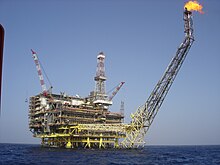Bouri Field
| Bouri Field | |
|---|---|
 ENI Oil Bouri DP4 is the biggest platform in the Mediterranean sea. | |
| Location of Bouri Field | |
| Country | |
| Location/block | Pelagian Basin Block NC41 |
| Offshore/onshore | Offshore |
| Coordinates | 33°53′N 12°37′E / 33.89°N 12.61°E |
| Operators | |
| Partners | National Oil Corporation |
| Field history | |
| Discovery | 1976 |
| Start of production | 1988 |
| Peak of production | NA |
| Abandonment | NA |
| Production | |
| Current production of oil | 60,000 barrels per day (~3.0×106 t/a) |
| Producing formations | Bou Dabbous-Tertiary |
The Bouri Offshore Field is part of Block NC-41, which is located 120 kilometers (75 mi) north of the Libyan coast in the
Discovery and development
Overview
In 1974, the Italian oil company Eni S.p.A. signed a production sharing agreement (PSA) awarded by the state-owned National Oil Corporation (NOC) of Libya for onshore and offshore exploration in areas near Tripoli. This is where the Bouri field was discovered offshore at a depth of 8,700 feet (2,700 m) in the Gulf of Gabes by Eni's subsidiary company Agip Oil in 1976. The Bouri field is jointly operated by Agip and NOC.
The first phase of development, costing nearly $2 billion, was completed in 1990. This was immediately followed by commencement of a second development phase which entailed the drilling of 55 new wells and construction of three additional platforms, with production initiating from two oil platforms (DP4 and DP3) in August 1998.
In 1995, the Bouri field was producing nearly 150,000 bbl/d (24,000 m3/d), followed by a sharp decline to 60,000 bbl/d (9,500 m3/d) in 1998. This decline was largely a result of the country's inability to import enhanced oil recovery (EOR) equipment under United Nations sanctions, specifically Security Council Resolution 883 of November 11, 1993, which banned Libya from importing refinery equipment. The situation has improved since the UN Security Council officially lifted sanctions against Libya during September 2003 and foreign investment is expected in the future. In 2006, Eni reported that the Bouri field was producing about 55 kbboe per day.[2]
Block NC-41 Facilities

Block NC-41 contains three known petroleum reservoirs; one oil reservoir and two gas reservoirs. NC-41 has two production platforms: DP4 and DP3. The latter is tied back to the DP4 platform located 6.5 km northeast. The DP4 platform is permanently moored at a single point to a
Field Development Since 2004

In 2004, Agip Oil commissioned Saipem S.p.A. for additional development projects related to the Bouri Field. The project carried out through a joint venture between Saipem and Korea's Hyundai Corporation, which fabricated process and utility modules. Apart from drilling modules, designed and with fabrication follow up by Saipem, the contract covered installation of two drilling and production platforms in 160 meter water depths. Overall, twenty-seven modules, ranging in weight from 500 to 1700 tons, and totalling 26,000 tons, were installed. Work conducted on the Bouri Field DP-4 Rig, included; a Removal project: decommissioning and removal of one of the two drilling rigs and associated modules from the DP-4 platform. These operations were carried out utilising the Saipem 7000, which is the world's third largest crane vessel.[3]
Export Development
The
Djeffara-Pelagian Basin Province: Formation
The Bouri field is situated in the Djeffara-Pelagian Basin Province (also known as the "Pelagian Basin"), and produces from the Bou Dabbous-Tertiary TPS. The Province is primarily an offshore region of the Mediterranean, located off eastern
Notes
- ^ Middle East Reservoir Review Archived 2010-02-15 at the Wayback Machine
- ^ 0?xoidcmWopk&lang=en&sessionId=22107205 Libyan Operations[permanent dead link] Eni 2007
- ^ L. Petrilli (1992) Saipem: Bouri project Archived June 22, 2006, at the Wayback Machine
- USGS
- ^ T. Ahlbrandt (2002) p.17; and Petroconsultants (1996)
References
- Energy Information Administration (2012) Libya: Country Analysis
- P. Mobbs (2002) Mineral Industry of Libya
- Thomas Ahlbrandt (2001) Sirte Basin Province: Sirte-Zelten Total Petroleum System U.S. Geological Survey
- Teknica Petroleum Services Ltd Bouri Field: Project Review

